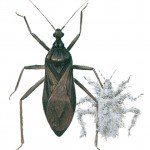
( Latin: , Reduvius personatus )
The larvae of this bug produce a sticky, oily substance, to which dust and debris adhere, so that they become well camouflaged.
The adults, on the other hand, are glossy brownish or dull black. They have well developed wings and fly well. The rostrum or proboscis is very short and powerful and when not in use it is folded back beneath the body. The female lays up to about 200 very large, brown eggs which are deposited singly and at random.
Development is slow and at ordinary room temperature may take a year from the hatching of the egg to the adult insect. Fly bugs are predators that suck the body fluids of other insects. They are often found in lofts, outhouses and similar places where there are usually other insects of various kinds. They avoid the light and spend the day hidden in crevices. Specimens found in houses are usually strays from their normal habitat, but exceptionally they may be hunting bed bugs.
There have been a few records of fly bugs biting sleeping humans, and they may also bite in self defence if picked up.




